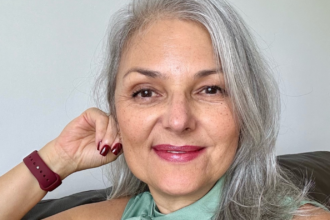Jessica Bryant Klagmann, the author of “This Impossible Brightness,” will see her debut novel released by Lake Union Publishing on February 1, 2024, currently featured as an Amazon First Reads selection for January!
“This Impossible Brightness” is a speculative fiction work full of hope, representing an incredibly imaginative debut that explores themes of grief, connection, and the power of narrative in a setting on a remote island threatened by climate change.
The plot unfolds in 2026, as the North Atlantic coast is gradually being swallowed by the waters. Sea levels surpass projections, homes slide towards the water, and island communities are forced to relocate. Amidst this chaos emerges Violette, a quiet island town that, at least for now, has escaped the impacts due to its elevation and location. However, the arrival of new inhabitants to the island is not just rare but practically non-existent. Opting to reside in a place with such a grim future seems as absurd as moving there.
Alma Hughes seeks solitude after the mysterious disappearance of her fiancé, and Violette proves to be the ideal location. With two cousins and an aunt among the 271 island inhabitants, she has some connection to this isolated place. However, upon arriving, Alma discovers that the peculiar town hides its own mysteries, which will soon entangle her intensely.
Locals claim that the radio tower dominating the town transmits messages through appliances, dreams, and even the sea itself. When lightning strikes the tower, illuminating the sky with intense brightness, Alma finds herself entangled in the unexplainable aftermath of one of Violette’s deadliest storms.
As the sea advances, threatening the island’s existence, the deaths and lost memories of the recently departed also afflict the community. Alma, with a unique connection to the lost, may be the only one capable of helping them move forward. However, to do so, she will have to confront her own tragic loss.
“This Impossible Brightness” uniquely captures the beauty and grandeur of nature, as well as our fragile position in the world, while offering a reflective meditation on loss, grief, and connection.
What inspired the creation of the story “This Impossible Brightness”?
I set out to write about someone who was introverted and sensitive, who struggled because of these traits because she also wanted to make a difference. I had been thinking about that old advice to “write what you know,” and I realized that what I know really well is being an introvert in what often feels like an extrovert world. I’ve also thought and written about grief for some time, in the most hopeful way possible, and I wanted to explore that in more depth in something of novel length. I chose the North Atlantic setting because I’d always been curious to write something about that area where I spent time as a child. I have family on my father’s side from Nova Scotia, and so there was an element of homage there, with the setting and many of the names used in the book. But it is still a work of complete fiction, despite the many influences from my life that appear.
How did you approach building the dystopian island setting and its connection to climate change in your novel?
The setting is actually what initiated the dystopian aspect. That the place is being lost to rising seas grew as I was writing. I had ideas for other settings early on in which climate change wasn’t as prominent a feature, but once I decided on the North Atlantic, I thought realistically about what would be happening in this place decades from now. And, realistically, that part of the world is already experiencing more frequent, destructive flooding. But I also didn’t want to paint too bleak a picture. It’s a story about hope, after all. So, I tried to keep the climate change aspects as a backdrop to the human story of Alma learning to listen to the world around her.
Alma Hughes faces significant grief in the story. How does this theme unfold and influence the narrative?
We see Alma grieving right away, as she’s on the boat traveling to Violette. At first, all she wants is to be allowed to grieve in her own way. She doesn’t want to move on, which is what many people in her life suggest she should do. She brings many of her lost fiancé’s things with her to this new place, and her grieving includes spending time alone in her house with these items. Because she’s moved to this place to withdraw from society, when she’s faced with the unique situation of being the only one who can see and speak to the Echoes, it’s the best of both worlds for her—a sense of community that doesn’t ask much of her emotionally. It even offers her the possibility that she might find her fiancé’s echo out there. We see her spiraling into solitude, into a sorrow disguised as obsession. Eventually, she’s pushed to connect again, and that’s the heart of the story—Alma learning to connect again to herself, to other people, to family, to the natural world. It’s ultimately what finally pulls her out of the grief.
The radio tower and its mysterious messages add a unique touch to the plot. Where did the inspiration for this element come from?
This was not part of the first few drafts of the book. I was initially fascinated by Marconi’s wireless station in Glace Bay, Nova Scotia. The idea that Alma and Alex had sent messages to one another as kids was always there. But while I was doing some research, I read a story about a town in New Brunswick where the residents heard broadcasts through their home appliances. I immediately stopped reading about it because I knew I wanted to fictionalize it, and I didn’t want to know too many of the actual facts. I thought a lot about these broadcasts, and why they might be meaningful to someone who is grieving. For someone who is dwelling in memory, the idea that the broadcasts were not coming over the airwaves in real time, but rather traveling from the past as echoes, fit the story perfectly.
The narrative seems to intertwine elements of speculative fiction, romance, and environmental reflection. How did you balance these different aspects?
I didn’t think much about genre while I was writing. I never really have. When I started writing seriously in college, magical realism quickly became the genre that resonated with me most. Now, I think speculative is a better fit for what I write. There are more projections of possible futures. It’s a little more science fiction and dystopian. I’ve also always written nonfiction that dwells on the environment and how we connect to the natural world. That has found its way into my fiction as I’ve learned that fiction can often reveal truth more easily than nonfiction. But the many aspects of a narrative—romance, tension, reflection—all exist as essential parts of any narrative for me. No matter how speculative a story gets, if it isn’t telling a grounded story that people can relate to, it isn’t going to work.

The book highlights Alma’s unique connection with the deceased. How does this dynamic contribute to the exploration of grief and resilience?
Alma’s an empath, in addition to being introverted, and she’s always thought of this as a weakness. But her experiences in Violette, and her interactions with certain characters, show her that it can be a strength. For example, it’s because of this empathy that she’s able to see and speak to the echoes and help them move on. It’s her connection to the deceased that pushes her to both work through her grief and to reevaluate this part of herself that she’s never fully understood. She spirals downward for a while, but by the end, she’s a much more confident, resilient person for it.
Violette Island is portrayed as a peculiar place. Are there specific influences you incorporated into creating this fictional community?
I drew a lot on my memories of visiting Nova Scotia as a child, and I reached out to some of my family members. They sent me photos and told me stories about their time there as well. I also did a lot of research and read about places in the North Atlantic, pulling together pieces of many different islands and coastal communities. It really is a patchwork of places that I stitched together over the course of writing the novel.
How does the protagonist Alma evolve throughout the story, especially in relation to her journey through grief?
Alma’s at a pretty low point when we meet her in the beginning, but as the story progresses, she sinks even deeper. With her fiancé gone, her dog dying, and the ghosts she finds herself with, she gets quite lost. She goes further into her sorrow, becomes obsessive about connecting again with her lost fiancé via the radio, and spends as much time as possible with the dead rather than the living because she finds it easier to manage the many emotions. But each of the ghosts has something to teach her about living, and by the end she’s forced to come to terms with the fact that she has spent too much time avoiding people and society. That she’s been paralyzed by her fear of being herself in the world. Her evolution as a character is fully realized when she accepts who she is and appreciates that she has something to offer.
The novel addresses the human relationship with nature. How do you hope readers will reflect on this theme after reading the book?
I grew up with a connection to the natural world—my father was an organic farmer and a beekeeper, and both of my parents became herbalists while I was young. We hiked, canoed, and camped all the time, and they instilled that love of nature in me from the beginning. I’ve always found so much comfort in the natural world, and whether I’ve been in New England, Alaska, New Mexico, or anywhere else, being in nature has been the best way for me to work through difficult times. I hope readers feel inspired to seek solace in nature as well, and to consider what we all can do to heal our planet.
What message or emotion do you hope readers will take away after finishing “This Impossible Brightness”?
I hope people come away with the sense that, while telling stories is important in life, listening is just as essential, whether that means listening to ourselves, to other people, to the “ghosts” we carry with us, to the land that surrounds us. And that while life is filled with unknowns, sorrow and hope can coexist. They have to coexist.
Follow Jessica Bryant Klagmann on Instagram










